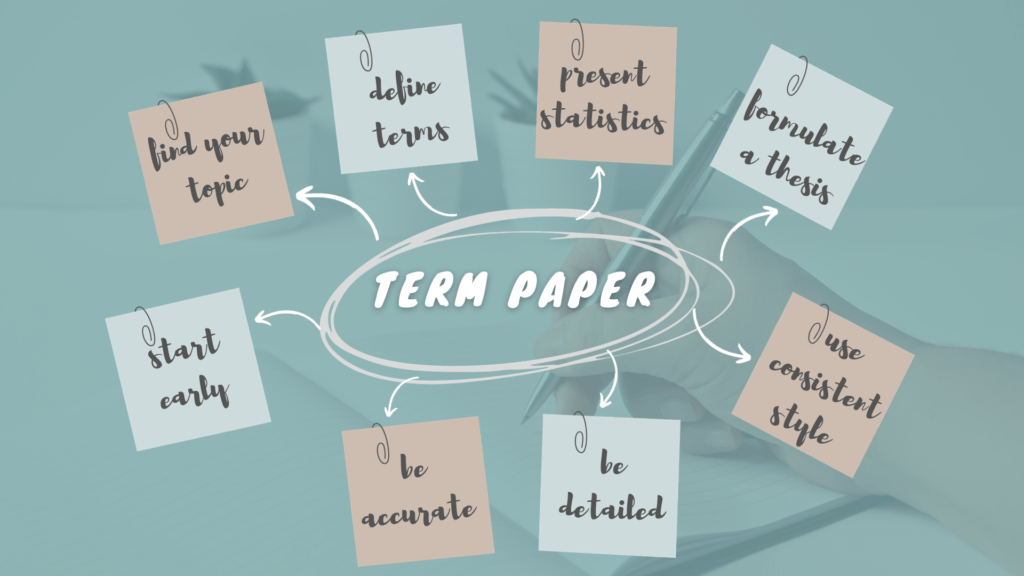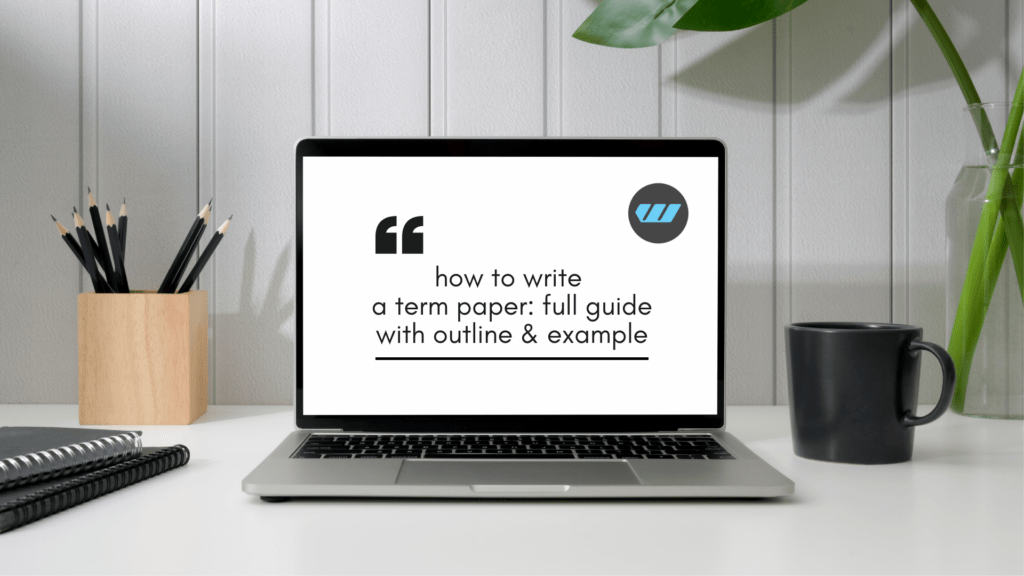You just got your term paper assignment and have no idea what to do or how to start? This guide will navigate you through every step of the process, from idea formation to final editing and proofreading. We will start with outlining, drafting and brainstorming, and get you through the writing part in no time. So, let’s dive into the question of how to write a term paper.
If you want to know everything you will need about term papers, this guide, written by the writers at the best essay writing service will help you along.
Table of Contents
What is a term paper?
A term paper is an academic milestone more so than anything else. As a student, you are tasked with learning and then transmitting that knowledge to others. A term paper is just that, a way to show what you have learnt, and disseminate the knowledge to others. Unlike other types of academic writing, a term paper is more detailed, requires more research, and is generally seen as the hardest piece of written work aside from a thesis.

The aim of a term paper is to showcase your understanding of the subject matter and how well you handle pressure and deadlines. In this context, a term paper proves invaluable. In terms of scope, term papers may zero in on an important historical event – if you’re studying history – a scientific concept, or a contentious argument. The choice hinges on the prompt created by your academic advisor. The typical length of a term paper can stretch to five or seven pages, and is generally the prerequisite to attend end-of-semester examination. But, it is also a part of the weighted grade you’ll receive, which only adds to its importance.
For the average student, writing a term paper takes around two weeks, and is a process many do not fully understand. Term paper starts from a very basic element, a question.
Say your teacher wants you to analyze the arguments for and against US involvement in World War II. How would you start? By asking a question; something like: Why did the US enter the war? Or, why did the US waive its neutrality and entered the war.
This opens the door for you and allows you to find an article or two that then leads to the second step, and so on and so on, until you are done. The problem is many students do not know how the process works, or what skills are needed to get the job done. To write an excellent paper you need to plan carefully, adapt to new conditions, be analytical yet persuasive, and understand how referencing works. In addition, the paper has to be formatted to specifications of your chosen citation style – APA, MLA, Chicago/Turabian, Harvard, etc. This is a lot of work!
What is the Purpose of a Term Paper
At its core, a term paper serves to test your ability to understand arguments and defend them using written constructs within a pre-determined time period. Put simply, it tests your ability to navigate complex ideas when faced with a deadline – something that comes in handy in almost every job you’ll ever have later in life. If you can understand a complex event, a scientific theory, or a debatable stance, based on the directive from your academic mentor, you can manage pretty much anything that is thrown your way.
A typical term paper will be between five to seven pages, and represents the pinnacle of writing tasks in the semester. The process of term paper writing, even when the topic is prescribed, can be an arduous and time-consuming undertaking. To succeed you need meticulous planning, good composition skills, and scrupulous analysis, structure, and edit
Doing the Basics Right Saves You Time
As Seneca famously said, “Luck Is What Happens When Preparation Meets Opportunity.” In short, prepare, prepare, prepare. To create a perfect term paper you need to know, well in advance, how it will look, what will it be about, and how will it be structured. This then allows you to simply fill in the blanks as you go. But, if you start a day before submission, you’re toast – or, you can always ask for help from us J – because the result will be Red Bull frenzy induced compilation of internet’s best hits. And trust me when I say, your teacher has those stored in memory; you’re not the first student to turn a deaf ear on old Seneca….

So, let’s see how to start your term paper:
- Select your topic – If possible choose something that you’re personally interested in. When you choose early, all the good topics are still free, so keep that in mind.
- Research your topic – Once chosen, sit at your computer and run through Google Scholar or your University Library for anything that pops up when you type in your exact topic.
- Create an outline – When you have a basic understanding of the topic, prepare an outline. It’s always going to be fairly standard, so once you get it right, you can re-use whenever you need to in the future.
- Thesis statement – Now starts the tricky part. Just kidding, this is still the Top Lane, we’re not even close to the Jungle. Thesis statements are always pretty similar. Jolt down your guiding question and then, based on what you’ve read, write a one sentence argument. For example, if writing about solar and wind, you might go with: Solar and wind power are the future of energy production because fossil fuels are unsustainable.
- Topics, topic sentences, and paragraphs – Every paragraph starts with a topic sentence that describes what the paragraph is talking about. The easiest way to understand is this. If writing a paper about wind and solar, you would need at least three topic sentences – 1)Wind 2)Solar 3)Benefits of using wind and solar. Naturally, a term paper needs much more than just three, but you get the idea.
- Conclusion – Once you’ve written down the topic sentences and outlined the paper, note your own expectations of what you’ll find in the conclusion. This will help you understand what is happening, and when you’re actually writing the conclusion it will tell you if you were right or wrong.
Pro tip: If all of this is too much for you, there is always the possibility of asking professionals for help. Our team of term paper writers are here to help, so feel free to reach out!
Structure of a Term Paper
As you’ve probably guessed by now, every paper has to have a specific structure. In general, you can expect to have at least three parts – introduction, body, and a conclusion. However, longer papers may need several sub-sections, perhaps even an abstract or a summary, and a page dedicated to bibliography.
A typical term paper has three to five body paragraphs that form the backbone of your arguments and analytical discourse. A bibliography is always needed, even if your sources predominantly comprise course materials or excerpts from consulted textbooks. Depending on the chosen style, you will need either a Works Cited page (MLA), a Reference page (APA) or a Bibliography (Harvard, Chicago). Given its pivotal role in determining your final course grade, make sure to adhere to the highest writing and editing standards.
Term Paper Outline
- Title page – this is where you enter your name, teacher name, school, class, and date. The formatting will depend on your chosen style
- Introduction – Introduction sets the stage for your arguments. This is where you present statistics, define helpful terms, and finally present your thesis statement. IMPORTANT: Thesis statement is always the last sentence in the introduction.
- Body: Depending on the topic the body paragraphs may look like this:
- Body 1: Historical setting or development
- Body 2: Current state of knowledge about the problem
- Body 3: Main argument and potential implications
- Body 4: Argument for
- Body 5: Argument against
- Body 6: Summary
- Conclusion: Bring all of the body arguments together and restate your thesis statement.
- Bibliography: Provide references for all sources cited in the term paper using the style of your choice
Now let’s get to the nitty gritty of the writing process.
Topic Selection– In most cases teachers or instructors will provide students with a list of pre-approved topics to choose from. But, in some cases you will get the opportunity to choose for yourself. This is both a blessing and a curse, because it can lead you into a deep pit of despair if you are not careful.
Length – Every paper will have an assigned length. You should never go under the minimum or the maximum word/page count, as that will take points away from your final score. If the prompt asks for 10 pages, write that.
Sources – Consult your school library, Google Scholar, and any other database that has access to journals and books on your topic.
Simplify – While it is admirable to be able to write in a high-brow voice, it’s much better to use plain language as much as possible, but staying within the confines of academic jargon. No don’t’s, couldnt’s, or should’ve. If something is too complicated to explain simply, you do not understand it properly. Ask for clarification.
Do not be afraid to wander – Choosing a common topic may be a safe bet, but your teacher will grade you higher if you take a topic nobody else even though about. Brownie points are there for the taking. Just make sure you know what you’re talking about!
Don’t overextend – While the entire combined histories of all monastic orders may seem like an interesting topic (well, to us at least), it is waaaaaaay too broad to cover in 5 or 10 pages. Heck, that would probably take an entire compendium with multiple volumes. In short, don’t be a megalomaniac and choose a topic that fits in 5 pages.

How to Write a Term Paper: The Writing Process
Before starting your write up, the teacher will expect a proposal. This is a very short summary of the topic, your thesis statement, and a few sources. The goal is to present a topic that you can defend and ask the teacher to approve it.
So how do you write a proposal? Start by writing down your thesis statement and guiding question. Then identify three to four sources and jolt down key statistics and pieces of information that are linked to your thesis statement. The goal is to show you’ve done the work. The proposal will generally have a full outline (see above) so that the teacher knows what you are planning to do. If you explain what the topic is and why it is important in writing, the teacher will accept the proposal.
Introduction, well, Introduces the Term Paper
Your essay has to start strong, which is why 99.99% of all introductions start with a hook that captivates the audience. A hook can be anything, a statistic (like 40% of people in the US have no savings whatsoever, which means around 140 million people are completely broke – now that’s a hook, line, and sinker).
Once you know the reader is hooked, you present a brief overview of the topic you will discuss. This is where you bring statistics, data, and broader theories or concepts that may relate.
The end of the introduction is always reserved for the thesis statement, which is the last sentence of the introduction.
Try to be concise – not more than ¾ of a page (cca 200-250 words), but detailed enough so that the reader understands what the paper is about.
Writing the Body Sections
When you are certain you can understand the concepts and arguments presented in the literature, it’s time to write your body paragraphs.
The goal is to provide the reader with enough context and argumentation to prove your point. So, if you’re writing about the advantages of nuclear energy, you have to provide evidence from the literature as well as a thorough analysis of all benefits and drawbacks. The goal is to be as objective as possible, while ensuring your results are accurate.
Do not dwell on too much detail, you cannot fit all of the information in a 5 – 10 page paper. Isolate the most important pieces of evidence, maybe 3-4 and focus on those.
As a rule of thumb, you will aim for 4 – 5 body paragraphs minimum, but in most cases you will need more. The first section should be the literature review, where you analyze state-of-the-art of the topic you are writing about.
Following the literature review is your analysis, which draws from the information you’ve collected. It’s important to note, do not try and make up new stuff, or draw conclusions in this section. Simply analyze and summarize the findings in your own voice.
The last paragraph of the body section can be your own summary, where you present a different opinion. Be concise and do not go into too much detail, simply note if you think there are any discrepancies in the literature.
Remember: Always start your paragraphs with a topic sentence and try to contain the information within the paragraph to the topic.
Writing the Conclusion
Conclusion is the most important part of the term paper, even though many do not give it enough attention. This is where you put everything you’ve written together and summarize key findings.
Important: Conclusion is not the place to add new information or knowledge!
To write a good conclusion keep in mind your initial research question and thesis statement. The goal of the term paper is to answer the question and prove your thesis statement is correct. Has your paper done this? Write it down and explain why or why not your initial proposal was correct. A thesis statement can be wrong, and you must acknowledge this in your conclusion.
In the conclusion:
- Summarize your findings
- Discuss implications for future reseasrch
Editing and Finalization
The final word of the conclusion has been written, references added and alphabetized, the paper and the title page formatted. You are finally done. Or, maybe not! Now is the time for the final edit.
Teachers, above everything else, hate reading papers with spelling mistakes and poor grammar. To make sure your paper does not annoy the teacher (you don’t want a lower grade), make sure it is completely free of any errors.
The best way to do this is by using a machine learning tool combined with close reading on your own. The machine will weed out the glaring errors, and you will finish the job.
Read through the draft carefully. Remove any fluff or excess words that add nothing to the argument. You will likely find several sentences you will want to change. Do this now. Once done, start the second read-through.
In this read-through you will hone in on the arguments. Do they make sense? Are statistics properly cited, and do you sound coherent? If the answer is no, you will want to fix the mistakes until satisfied.
Now, finally, you are done! Congratulations. Pat yourself on the back. Oh, wait, we forgot about the abstract!
Abstract Comes First, or Last
In no uncertain terms, do not write the abstract before you’ve completed the term paper. This is always the last part of the writing process, but strangely enough the one your paper starts with. Go figure.
When you do get to this stage, use our secret formula. Well, it’s not really secret but we like to think so. The abstract needs three parts to work well, the introduction, the method/procedure, and the conclusion/findings. Depending on the topic these will vary slightly but you will always find them in an abstract.
Introduce your topic and what you plan to do in two to three sentences.
Describe what method you will use – such as literature review, an experiment, or something else. Two to three sentences.
Define the results you obtained after using the method. Two to three sentences.
Remember: The abstract should be between 120 and 200 words in length, no more is needed.
FAQ
Conclusion
Writing a term paper is certainly a challenge, but it is also manageable if you dedicate yourself to the process. Prepare well in advance, read a lot, and do not be afraid to ask for help if you get stuck. Your teachers are paid to help you, so email them if you get stuck. Above everything, make sure you are interested in the topic, as that will make the process so much easier.



